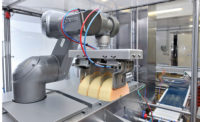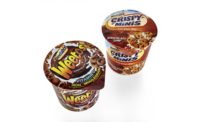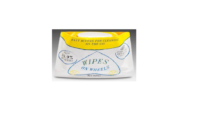Flexible packaging has transformed the packaging industry over the last few years. Pouches and bags are packaging new products all the time. As more items make the move to flexible, a greater demand exists for materials that can accommodate these new foods and beverages. The latest films and coatings work to provide improved product freshness, cost saving and sustainability.
Toray Plastics (toraytpa.com) began offering the Torayfan PC5 metallized BOPP film earlier this year. It is versatile ultra-high oxygen and moisture barrier film for use in tri-laminations, as a foil replacement and as an overwrap. The ultra-high-barrier layer is resistant to crazing on one side while the other side is corona treated for bond strength in co-seal adhesive applications and in extrusion and adhesive 3-ply laminations. In order to provide brand integrity, the film protects against oxygen and moisture in gas-flushed applications so food will stay fresh.
“New foods are introduced to the consumer daily and end users and converters want more than the packaging status quo,” says Kerri Boyens, product manager, Torayfan Division. “PC5 film is an innovative foil-replacement and barrier packaging solution that offers clear competitive advantages. It has superior oxygen- and moisture-barrier functionality, is versatile and readily available, and is an economical solution, particularly when compared to foil.”
Also striving to deliver improved oxygen barrier properties, LPS Industries (lpsind.com) launched two new film families in January. The Ethylene Vinyl Alcohol (EVOH) co-extrusion material delivers on the oxygen-barrier front while the ultrathin option is an effective coating made of nanoparticles.
“Our solution is a new film that combines PET with a coextruded Ethylene Vinyl Alcohol copolymer (EVOH),” says Domenick Pasqualone, vice president of LPS Industries. “Not only is it cost-effective for larger runs of commonly used gauges it is also crystal clear, odorless and safe for consumable product contact. It can also provide multiples of the oxygen barrier properties of PVDC-coated PET.”
The thinner film also offers oxygen barrier properties by applying a layer of nanoparticles over PET film. Human hair is around 890 microns thick, but the nanoparticles are only 0.2 to 0.4 microns thick.
|
Expert flexibility
Food and Beverage Packaging discussed the flexible packaging market with Dan Walter, vice president and director of BioProduct at Penford Products (penford.com).
Food & Beverage Packaging Magazine: What do you see as the biggest trend for flexible packaging materials for food and beverage packaging in 2014?
Dan Walter: Lighter, flashier materials to catch the consumer’s eye while driving the package/product ratio down to meet retailer needs.
FBP: What is the biggest challenge for flexible packaging materials face moving forward?
Walter: Recycle versus compostable. Maybe a look at the PET bottle could be an analog example of where we are headed; if the package is not compostable then the drive for sustainability will reside in the recycle stream. On the surface this may be easy to accomplish, as it is technically for PET. In practice, getting used and discarded packaging into the recycle stream becomes more difficult as the packaging becomes more ubiquitous.
FBP: How is flexible packaging impacting sustainability in packaging? And what materials are making flexible more sustainable/recyclable?
Walter: I believe flexible packaging challenges are related to the need for both oxygen and water resistant surfaces, which may put a significant burden on developing truly sustainable solutions.
FBP: Flexible packaging remains a growing trend in the food and beverage industry. What has contributed to that success and what is necessary for future flexible packaging success?
Walter: Single servings, smaller portions, fresher, more natural ingredients, freeze/thaw stability and cook-in-container packaging are some of the drivers in the flexible packaging space that will continue to drive the need for innovation and push the envelope on what is possible and practical within the space. Identifying the critical-to-quality aspects of market needs are always required in achieving and maintaining the position as an innovative leader in any space, flexible packaging is no different.
|
“Nanoparticles, which are so small that individual particles are invisible to the human eye, are truly cutting edge technology,” comments Pasqualone. “Our new nanoparticle-based film has a coating that is only a fraction of a micron thick, yet offers unsurpassed oxygen and moisture barrier properties.”
Light and thin does the trick for some films, but others are looking for ways to get a thicker, stronger film that is still cost-effective and sustainable. Cryovan Technology (CT) films from Sealed Air (sealedair.com) offers new films that provide thinner gauge option without compromising performance or raising costs. These new films, Cryovac’s CT-300, CT-500 and CT-700 series, offer a potential source reduction of up to 50% compared to polyolefins and 60% compared to PVC films. The reduced mass requires less heat for the film to shrink, which further saves on energy and production costs.
“By expanding our packaging portfolio with the release of our new CT films, Sealed Air can not only serve a wider range of shrink applications, but also enable our customers to package in a more sustainable manner,” says Jim Oddo, vice president marketing, shrink packaging solutions for Sealed Air’s Product Care division. “The CT films exemplify Sealed Air’s SmartLife™ approach, which emphasizes a commitment to sustainability through packaging solutions that provide efficient protection while reducing costs, waste and overall environmental impact.”
DSM (dsm.com/packaging) is showcasing a portfolio of flexible food packaging at PACK EXPO International in November. One film in particular, Arnitel, offers an intelligent packaging option for perishable foods. Arnitel is a selectively breathable barrier film that can balance oxygen and CO2 levels in package to keep the product fresher longer. DSM has launched Pack-Age film that allows cheese to ripen in the film while keeping the cheese dry like it is in traditional ripening processes.
Whether flexible packaging is saving on costs, offering better protection, getting thinner and light, or allowing product to ripen while packaged, the innovations aren’t stopping any time soon. Flexible continues its march into more and more segments of the packaging industry all while becoming a more sustainable, lighter, more durable and more intelligent packaging solution.







